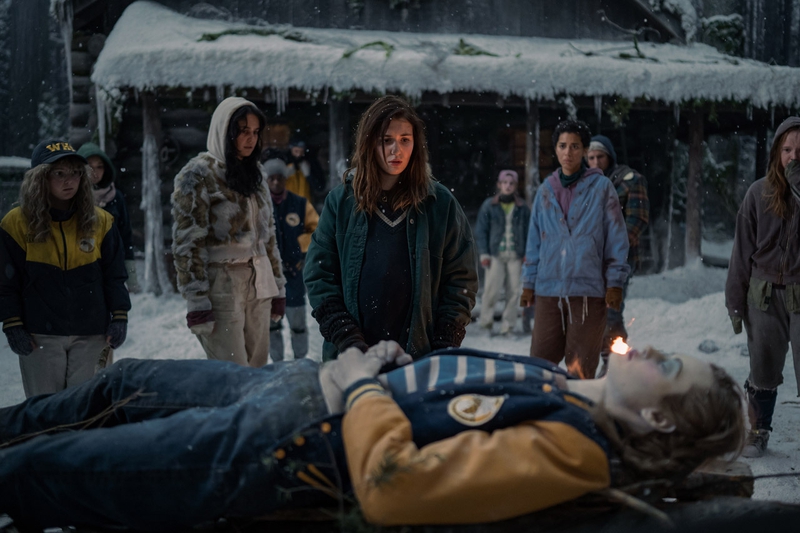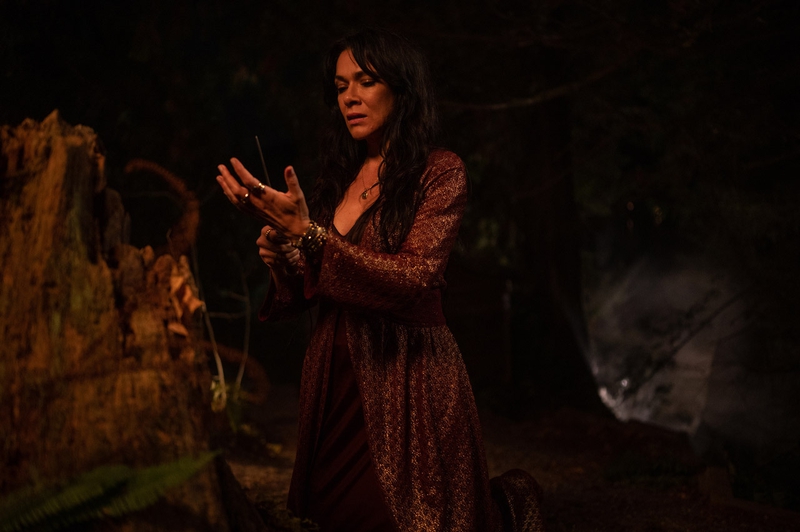When you think "eaten alive," what image comes to mind? For me, it's the ubiquitous scene of the flesh-hungry living dead as they descend upon the poor schmuck who gets torn apart, limb from tendon, tendon from flesh, flesh from viscera, like so much pulled pork. A veritable horde of monsters and their associated subgenres have been constructed around the particular terror at the heart of such a scene- literally every zombie film has one!- which is why it also represents the terror at the heart of this column: the anxiety around eat lest you be eaten. Sometimes though, that consumption shows up in more subtle ways. Less teeth-forward, shall we say.
Shot for a mere $375k, Sam Raimi's The Evil Dead remains a perfect horror film. Possessed of that B-movie horror camp sensibility you either love or don't, it's also a film with layers: deep in conversation with the genre while influencing it simultaneously. Indeed, fans of Yellowjackets will find some key reference points in The Evil Dead, particularly with regard to treating the wilderness as a character with agency and consciousness.
Though widely credited with establishing "the cabin in the woods" setup as a tried and true horror trope, Raimi was, in many ways, simply referring back to some of our oldest and most enduring storytelling. Mythic monsters have always been located in associated lairs of some sort. Since the Middle Ages, European fairy tales and folklore have frequently identified the forest as a place where evil dwells. While Christian inflections to such storytelling are unique to Europe and European influence on colonial America, storytelling about the Gothic forest appears the world over. It is as Elizabeth Parker writes that "the woods- symbolically- are all around us"; that "our imaginations through the centuries provide us with an extensive history of tales that tell us to fear the woods," which is why she makes this "archetypal site of dread" her subject in The Forest and the EcoGothic: The Deep Dark Woods in the Popular Imagination.
Nebulous as all monstrous entities are, the wilderness is widely regarded as a source of sublimity, the meeting place of beauty and terror, where one may meet the devil (or some version thereof). Nevertheless, a theme rendered in horror films like Deliverance, The Cabin In The Woods, The Happening, Antichrist, and The Witch. Parker writes that "we present the forest as Gothic in our stories because we think it is Gothic, because it frightens us, but it also frightens us because of the fearsome ways we have portrayed it in these stories." Our fear, she posits, is essentially a feedback loop.
In homage to Jeffrey Jerome Cohen's "Monster Culture (Seven Theses)," Parker distinguishes her own seven theses for "why we fear the forest," and though the others certainly bear relevance, it's the fifth that's most pertinent here: "the forest is a consuming threat." In other words, we see the forest as a living entity that actively wants to devour us.

In The Evil Dead, we follow five Michigan State students- Ash (Bruce Campbell), his girlfriend, Linda (Betsy Baker), his sister, Cheryl (Ellen Sandweiss), friend, Scott (Hal Delrich), and Scott's girlfriend, Shelly (Theresa Tilly)- as they retreat to a rural cabin where dumb curiosity leads them to accidentally unleash demonic forces that, one by one, take possession of their bodies and transform them into the evil Deadites. Straightforward as it is, the devil- and the delight- is in the details.
Before the group even arrives at the cabin, Raimi employs the first-person strategy of early slashers, where the audience views the film through the killer's perspective. Substituting stalking shots through well-lit windows overlaid with heavy breathing and the night rustle of suburban bushes, Raimi speeds up the pace and couples it with Joe LoDuca's score of frantic strings to suggest an unknown, unseen entity that traverses the woods.
It's a feature of the Gothic forest, Parker notes, that "the exact source of its terrors is often mysterious, shadowy, and just out of sight." Referring to Evil Dead specifically, she cites Cheryl's insistent observation that "there's something in the woods" before offering a litany of other projects from Twin Peaks to The Wizard of Oz that echo similarly vague sentiments about the "something," the "sort of evil in the woods."
In the case of Evil Dead, this out-of-sightness is accomplished by placing the viewer in that Subject position. It works to solidify the abstract "something" just enough to give it agency, to suggest consciousness, character, and especially malevolence. Yellowjackets employs the same strategy with similar ends. The wilderness isn't just malevolent, it's cunning. Manipulative. It sends the gust of wind that brushes the treetops so snow drops to cool Snackie's perfectly slow-roasted body before she burns all the way through. It tempts and beckons.

I've written before about hungry homes as iterations of The Swallowing. Wandering in the Gothic, haunted, or forbidden forest almost always leads one to a cabin, cottage, lair, or dwelling of some sort which functions as its own figurative mouth before the something-that-dwells-there even appears. In Hansel and Gretel, a pair of siblings get lost in the woods and discover a house made of sweets, home to a cannibalistic witch. In Twin Peaks, Laura Palmer (Sheryl Lee) is drawn in by Bob (Frank Silva), "the evil that men do," and the spirits of the Black Lodge: the mirrored juxtaposition not so much of the White Lodge, which we never visit, but the suburban Palmer family home. The forest is a devouring entity, its mouth emblematized in the door-mouth of some architectural structure which always leads to something else–something secret and starving that lies in wait.

In Evil Dead, as is often the case in horror, the women are the first to know what's happening. Cheryl hears voices and is overtaken by a presence as soon as they arrive at the cabin. Later, when the cellar door flies open (also big Swallowing energy), she's the most reluctant to enter and the most affected by the incantations once played, screaming for Ash to turn the tape off. Much like Laura Palmer, almost a decade later, Cheryl is then compelled to venture out into the deep dark woods. Something out there beckons and takes hold of her—quite literally.
Seemingly possessed, the trees' limbs, branches, and vines come alive to restrain and rape Cheryl, and if rape scenes in horror are generally disturbing, this one is also absurd. Though Raimi has since disavowed the scene, the terror of that absurdism is genuinely captivating and genuinely effective. The woods aren't merely haunted by a demonic entity, "They're alive!" And further, "They won't let us leave." Yellowjackets and Twin Peaks both echo this anxiety. In the latter, the Black Lodge- "the evil in these woods"- threatens to "utterly annihilate [Cooper's] soul." In season one of Yellowjackets, teenage Lottie (Courtney Eaton) senses that "it didn't want him to leave" ("him" being the still-mysterious former occupant of the cabin), while in season two's present timeline, adult Lottie (Simone Kessell) and Nat (Juliette Lewis) both come to a mutual recognition that they "brought it back with [them]."

Horror- and really all speculative fiction- is most evocative when the fantastic works to reveal something more true than even material truth. The woods, the forest, the wilderness is like any other natural landscape—it is alive, it does not exist to assist you, and it is fed by decay. It is, in a word, beguiling. And it's for this reason that the wilderness has long served as a metaphor for excavations of the interior. This is as much the case in The Evil Dead, Yellowjackets, and Twin Peaks as in The Epic of Gilgamesh. Our capacity to traverse and confront the external is a matter of the internal: what version of yourself you're willing to meet, who you're willing to become, and what you're willing to do to survive.
The secret of her father's abuse is the dark forest that consumes Laura Palmer. In Yellowjackets, the wilderness is God, a deity threatening to devour them. But it's also the girls themselves. The questions of whether the team just so happened to cross paths with this nebulous entity/energy, if it brought about the crash that led them there, or if they are the monsters in the woods is among the core considerations of the series—a question I'm sure will remain open-ended, even at its conclusion. In any case, both projects use the Gothic forest as a narrative device to explore deeper themes surrounding devotion, the feminine, and identity formation in wildly different ways.

The Evil Dead makes similar use of the haunted forest with regard to masculinity. Ash is the decided Hero of the film and one of the few designated "final boys" in horror history. He's not only the center of the group- Cheryl's brother, Linda's boyfriend, Scott's friend- but the most enduring of them. The metaphor of the living dead is at its most potent when a preexisting relationship is present between the one devouring and the one being devoured, and this tension is key in Ash's struggle. It's also one of the trademarks of The Evil Dead franchise—these folks don't just want to devour the world, they're mean about it too.
Once possessed and temporarily contained in their various ways, the Deadites use their personal relationships to taunt and inflict mental anguish on Ash with every intention of also inflicting physical anguish. Though the Sumerian Book of the Dead stipulates that they can only be destroyed by dismemberment and burial, it's Ash's refusal to accept the evidence of his eyes and ears, his refusal to accept his friends and family are gone, his desire to be the Hero that drives his emotional conflict over the course of the film. In other words, he's resistant to change: to separating who they once were from who they've become.

Heroism and self-preservation are often predicated on acts of monstrosity that have been interpreted as justifiable, whether or not they actually are. It takes Ash the entire course of the film to reach this understanding, and once he does, he's met with his own fallibility: exactly what adult Lottie and Nat are currently facing in Yellowjackets. The terror of the wilderness, of nature, is that it is an unconquerable, unshakeable part of us. And there's no escape from what lives in you.






